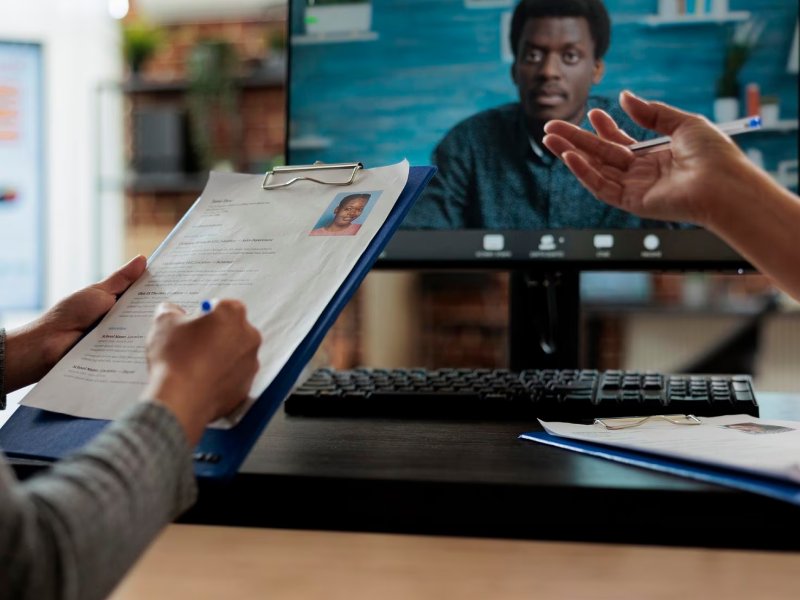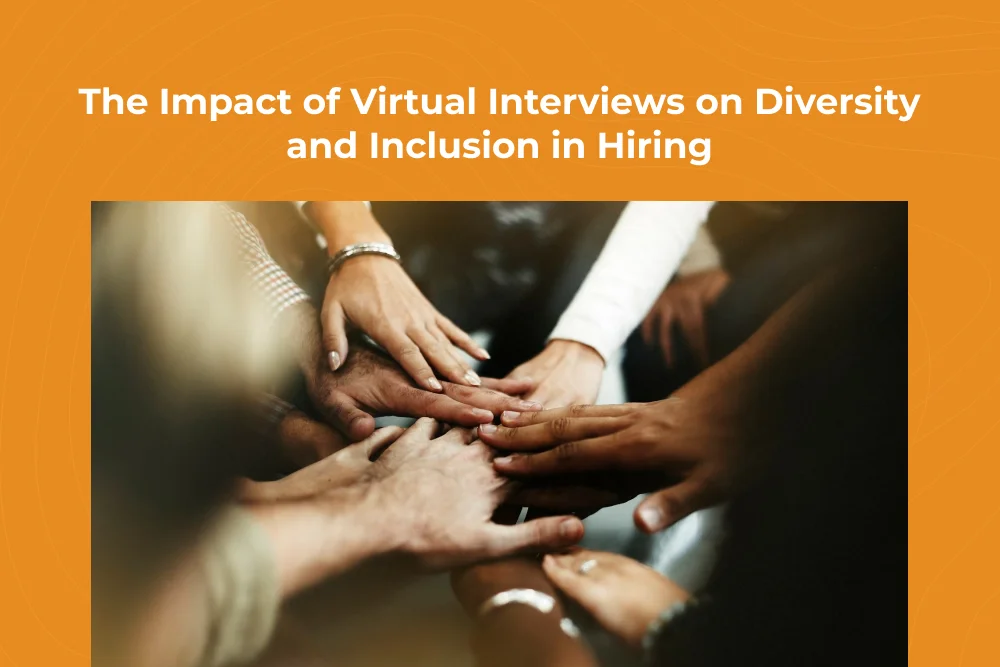In the quickly changing business world of today, businesses are seeking for innovative ways to improve their hiring procedures. One such solution that has gained significant traction is virtual interviews. These digital interactions have transformed the way employers connect with candidates, eliminating geographical constraints and offering a host of benefits. However, it is crucial to assess the impact of virtual interviews on diversity and inclusion in hiring practices. By examining the various dimensions of this approach, we can better understand how it shapes the workforce of the future.
Understanding the Concept of Virtual Interviews
Before delving into the impact of virtual interviews on diversity and inclusion, it is essential to grasp the concept and evolution of these digital interactions. Over the years, virtual interviews have evolved from basic audio calls to sophisticated video conferencing technologies. This evolution has allowed hiring managers to connect with candidates in real time, regardless of their physical location. Additionally, the role of technology in facilitating these interviews cannot be overlooked.

The Evolution of Virtual Interviews
Since its conception, the idea of virtual interviews has advanced significantly.
What was previously only a stand-in for in-person interviews has now become an essential step in the employment process.
Virtual interviews now give recruiters a more thorough insight of prospects while saving time and resources thanks to technological improvements.
The growing internationalization of the workforce is one of the main forces influencing the development of virtual interviews.
Companies are no longer restricted to recruiting applicants who live nearby.
The option to interact with talent from around the world through virtual interviews opens up a larger pool of candidates with a variety of backgrounds and experiences.
Furthermore, by removing geographical restrictions, virtual interviews have also transformed the hiring process.
Candidates were no longer obliged to pay for transportation costs or seek time off from their jobs so as to attend interviews.
This not only streamlines the application process for candidates but also enables recruiters to reach a wider audience and draw in top talent from other regions.
The Role of Technology in Virtual Interviews
Technology plays a pivotal role in enabling virtual interviews. From video conferencing platforms to AI-powered recruitment tools, technology has made it possible for employers to conduct seamless and efficient interviews. These innovations not only enhance the candidate experience but also provide employers with valuable insights into a candidate’s skills, communication abilities, and cultural fit.

Video conferencing platforms, such as Zoom and Microsoft Teams, have become the go-to tools for conducting virtual interviews. These platforms offer features like screen sharing, virtual backgrounds, and chat functionalities, which enhance the overall interview experience. They also allow for multiple participants, making it easier for hiring teams to collaborate and make informed decisions.
AI-powered recruitment tools have also played a significant role in transforming virtual interviews. These techniques can assess a candidate’s body language, tone of voice, and facial expressions in order to gain information about their emotional intelligence and personality qualities. This data can help recruiters assess a candidate’s suitability for the role and the company culture, even without in-person interaction.
Furthermore, technology has enabled the integration of assessments and simulations into virtual interviews. Candidates can now be evaluated through online tests, coding challenges, or virtual role-playing exercises, providing a more accurate assessment of their skills and abilities. This not only saves time for both candidates and recruiters but also ensures a more objective evaluation process.
In conclusion, virtual interviews have evolved significantly over the years, thanks to advancements in technology. They have become an integral part of the hiring process, offering recruiters a broader candidate pool and saving time and resources. With the continued development of technology, virtual interviews are likely to become even more immersive and efficient, further transforming the way organizations identify and hire top talent.
The Connection Between Virtual Interviews and Diversity
Virtual interviews have the potential to foster diversity in the workplace in several ways. By eliminating geographical barriers, companies can tap into a global talent pool, expanding their reach and increasing the likelihood of encountering diverse candidates.
When it comes to promoting diversity, virtual interviews play a crucial role. They enable companies to access talent beyond their immediate vicinity. This broader reach allows employers to connect with candidates from different backgrounds, cultures, and experiences. By actively seeking out diverse candidates, organizations can create a more inclusive work environment.

How Virtual Interviews Promote Diversity
Virtual interviews have revolutionized the hiring process by breaking down physical barriers. In the past, candidates were often limited to opportunities within their local area. However, with virtual interviews, talented individuals from all over the world can now be considered for positions, regardless of their location.
Furthermore, virtual interviews provide a level playing field for candidates. Traditional interviews often require candidates to travel to a specific location, which can be a significant obstacle for those with limited resources or mobility challenges. Virtual interviews eliminate these barriers, allowing candidates to showcase their skills and qualifications without the added burden of travel expenses or physical limitations.
Another way virtual interviews promote diversity is by reducing unconscious bias. In face-to-face interviews, subconscious biases can influence hiring decisions. However, virtual interviews focus solely on the candidate’s qualifications and responses, minimizing the impact of biases related to appearance, age, or gender. This helps ensure that candidates are evaluated based on their merit, rather than irrelevant factors.
Case Studies: Companies Increasing Diversity Through Virtual Interviews
Several companies have successfully leveraged virtual interviews to improve their diversity and inclusion efforts. These organizations have recognized the potential of virtual interviews to attract a wide range of candidates and have implemented strategies to capitalize on this opportunity.
One such case study involves a technology giant that implemented virtual interviews as part of its hiring process. They were able to contact applicants from underrepresented groups who would not have had access to conventional interview opportunities by doing this.
As a result, the workforce became more varied, and the workers contributed different viewpoints and experiences.
In another case study, a startup company utilized virtual interviews to expand its talent pool beyond its local area. By embracing virtual interviews, they were able to connect with candidates from different regions and backgrounds, ultimately increasing the diversity within their organization. This strengthened their capacity to serve a broad consumer base while also enhancing their business culture.
These case studies provide valuable insights into how virtual interviews can drive diversity and inclusion in the workplace. They show the beneficial effects that virtual interviews may have on a business’s capacity to draw in and hire individuals from a variety of backgrounds, ultimately resulting in a more welcoming and creative work environment.
The Influence of Virtual Interviews on Inclusion
While diversity focuses on representation, inclusion aims to create a welcoming and supportive environment for all employees. Virtual interviews can inherently contribute to inclusive hiring practices by breaking down barriers and promoting a more equitable selection process.
Breaking Down Barriers with Virtual Interviews
Virtual interviews remove physical barriers, making it easier for candidates with disabilities or those in remote locations to participate in the hiring process. This inclusivity allows individuals from diverse backgrounds to showcase their skills and qualifications without facing the often-challenging barriers associated with traditional interview settings.
For candidates with disabilities, virtual interviews provide a level playing field. They eliminate the need for candidates to navigate physical obstacles, such as inaccessible buildings or transportation challenges. This allows individuals with disabilities to focus solely on their qualifications and abilities, rather than having to overcome physical barriers that may inadvertently disadvantage them in traditional interview settings.
Additionally, virtual interviews benefit candidates in remote locations. In regions where job opportunities may be scarce, virtual interviews offer a lifeline. Candidates are no longer need to pay for their own travel expenses to and from interviews, which removes one major barrier for people with minimal financial resources. By conducting interviews virtually, companies can tap into a wider pool of talent, reaching candidates who may have been previously overlooked due to their geographical location.
The Role of Virtual Interviews in Inclusive Hiring Practices
By implementing virtual interviews, companies send a strong message about their commitment to inclusive hiring practices. Employers are willing to modify their procedures to accommodate diverse candidates, as shown by this strategy, which leads to a more inclusive and equitable workforce.
Virtual interviews provide a fair and unbiased platform for evaluating candidates. They eliminate potential biases that may arise from factors such as appearance, race, or gender. In a virtual setting, candidates are evaluated solely based on their qualifications, skills, and experiences, leveling the playing field for all applicants. This makes it easier to guarantee that the selection procedure is merit-based and devoid of any forms of discrimination.
Employing inclusive recruiting procedures is advantageous to both individuals and organizations as a whole. By embracing diversity and inclusion, companies foster innovation, creativity, and a broader range of perspectives. By enabling businesses to recruit and retain individuals from a variety of backgrounds, virtual interviews serve as an effective tool in attaining these goals and creating a more varied and dynamic workforce.
The Challenges and Solutions of Virtual Interviews
While virtual interviews offer a range of advantages, they also present their own set of challenges. Understanding these hurdles and implementing effective solutions is crucial for organizations striving to enhance their hiring practices.
Potential Drawbacks of Virtual Interviews
One potential drawback of virtual interviews is the possibility of technical difficulties, such as poor internet connections or software glitches. These issues can disrupt the flow of the interview and hinder effective communication between the interviewer and the candidate. Additionally, virtual interviews may inadvertently create bias based on the candidate’s comfort level with technology.
Overcoming Challenges in Virtual Interviews
By proactively addressing these challenges, organizations can ensure a seamless virtual interview experience. Investing in reliable technology infrastructure, conducting practice sessions, and providing support to candidates can help overcome technical difficulties and minimize bias. It is also essential to create a standardized evaluation framework to assess candidates consistently.
The Future of Hiring: Virtual Interviews and Beyond
The use of virtual interviews is predicted to continue growing and shaping the future of hiring practices. As technology advances further, new trends are expected to emerge, transforming the landscape of recruitment and further impacting diversity and inclusion in the workplace.
Predicted Trends in Virtual Hiring
Virtual hiring is expected to embrace new technologies, such as virtual reality and artificial intelligence, providing recruiters with even more immersive and intelligent interviewing experiences. The employment process might be transformed by these developments, which would make it more effective and inclusive and eventually promote diversity and inclusion in the workforce. The Long-term Impact on Diversity and Inclusion
As virtual interviews become more prevalent, their impact on diversity and inclusion is likely to grow exponentially. By enabling companies to tap into a global talent pool, virtual interviews have the potential to significantly enhance representation and create a more inclusive work environment.
In conclusion, virtual interviews have a profound impact on diversity and inclusion in hiring practices. By removing geographical barriers, leveraging technology, and promoting inclusivity, organizations can not only improve their recruitment processes but also foster a diverse and inclusive workforce. As we navigate the future of hiring, embracing virtual interviews and continuously adapting to new technologies will be vital for organizations striving for excellence in their diversity and inclusion initiatives.










